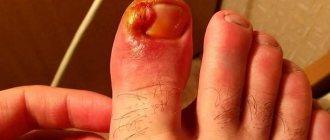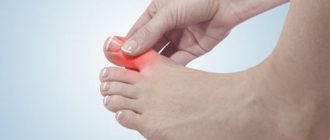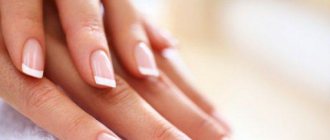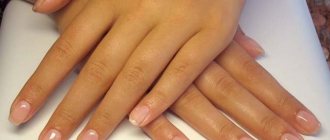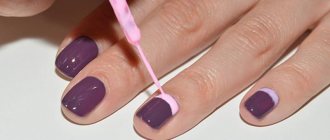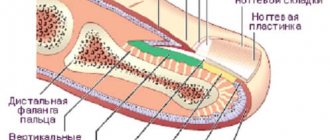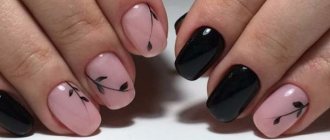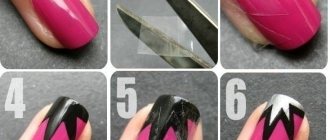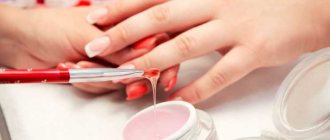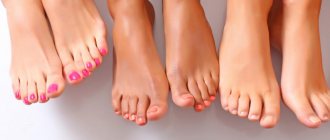Correcting an ingrown toenail using plates is an alternative to surgical treatment. It is used mainly in the early stages of ingrowth and demonstrates high efficiency (90%). The installation takes place under local anesthesia without tissue incision. The specialist has the ability to calculate the correction force. Any model does not create physical discomfort when worn, and their use allows you to effectively treat the resulting defect.
Plates for correcting ingrown toenails
The therapy that treats ingrown toenails is called orthonyxia. It refers to conservative methods. Its use demonstrates its effectiveness only in the initial stages of the disease. To carry it out, products made of plastic or metal are used. Correction devices have a certain rigidity. It is she who has a restorative and corrective effect.
The installed plates and staples reduce the pressure on the ingrown corner, as a result of which the ingrown nail takes the correct shape. This prevents the formation of core calluses that form in the area of the skin ridge. Today there are about 20 types of devices. Each model is developed for a specific clinical case, so the selection of a corrective device must be done by a doctor (surgeon). When choosing it, the stage of development of the pathology, the presence or absence of inflammatory processes, and other associated complications are taken into account.
Techniques used
The SM-Cosmetology clinic uses a number of techniques to restore the correct shape of nails:
Bracket 3 TO
This is a wire system made of chrome-nickel stainless medical steel. Thanks to a well-thought-out fixation, the bracket is installed as accurately as possible. The wire frame is made on an individual basis. To do this, a plaster cast is taken from the nail that requires correction, an exact copy is made and the shape of the bracket is adjusted to fit it.
Podofix
Hybrid technique for correcting irregular nail shape. This system is fixed like a plate - with glue, and the transition to the working state is carried out by tension - like a staple. Due to this combination, it is even used to treat deformities of the big toe nail - the thickest and most durable.
Combiped
It is also a hybrid system, a kind of half-brace that effectively affects one of the edges of the nail plate. Due to this, it allows you to achieve particularly good results when treating ingrown toenails.
golden plate
It is made of surgical steel with gold plating. This is a universal device that can be used as a regular glue plate, as a half-bracket, or as a full-fledged double-sided bracket.
Oniclip
Steel plate with adhesive fixation. Also suitable for correcting the shape of the second finger nail. Has a softer effect compared to previous systems.
BS plates
The most gentle method of restoring the shape of the nail. Our doctors install BS plates to prevent repeated deformations in the case of thin nails or single ingrown nails. This system is also well suited for children. It is attached with glue, has a waterproof fiberglass coating and is almost invisible.
Indications for use
Direct indications for use are:
- early stages of onychocryptosis,
- deformation and curling of excessively short nails,
- the presence of calluses in the area of skin ridges,
- constant relapses of onychocryptosis,
- the appearance of pain in the nail fold area,
- hypergranulation.
Practice shows that orthonyxia is highly effective when unilateral ingrown nails occur.
Types of plates
In Russia, the most common types of brackets and plates are the following models:
| Name | Description of the device |
| Fraser staples | Outwardly they look like thin wire. Its ends are hooks. They are wound onto the edges of the plate. In this way, pressure is generated on the plate, which aligns its edges |
| Combiped staples | They are used when one edge of a nail grows into the skin. One part of it has a hook that goes over the edge of the ingrown nail, the other part has a plastic platform. It is attached to the center of the plate using special glue |
| B and S plates | They are made of plastic and come in different shapes. A different model is selected for each patient. After installation, the device gradually lifts the ingrown corners and changes the direction of their growth |
| Goldstadt (half staples) | Made of metal, such corrective devices look like arcs. There is a hook at one end. It clings to the edge, which grows into the skin. The other edge is glued to the plate with glue |
| Podofix plates | Its body is made of soft plastic and there is a metal bracket inside. When installing it, the specialist first hooks the edges of the plate, then adjusts the wire tension |
| Onyclip plates | Externally, the devices look like an arc. Made of medical steel, covered with a layer of plastic on top. This design allows the doctor to set and precisely adjust the degree of tension. |
| ZTO staples | Made of stainless steel. The design consists of three parts: a loop in the center, hooks on the sides. They cling to the edges of the nail; using a loop, the doctor can adjust the tension |
| ERKI system | Two plastic hooks fastened together with a metal ring. Thanks to him, the doctor corrects the tension |
How to fix nails with a plate.
You can fix your toenails using a BS plate. BS are the initials of the first and last name of the inventor - the famous German podologist Bernd Stolz. The BS-plate is a medical product that is a strip of durable elastic polymer with a color and transparency close to that of a natural nail.
The plate is installed on the nail using a special biopolymer heavy-duty glue that is resistant to frequent contact with water. Therefore, installing a BS-plate does not lead to a shortage of hygiene measures - feet can be washed at least as often as usual, including using detergents, visiting a swimming pool, sauna, etc.
The operating principle of the plate is a spring. After gluing to the nail, the BS plate takes on the shape of the nail - an arc, but tends to the original shape - a straight line, due to which it pulls the ingrown lateral surfaces of the nail up and brings them over the soft tissues of the finger, eliminating ingrowth. The procedure can also be performed in case of relapses of ingrown nails after unsuccessful surgical attempts to correct an ingrown nail. The procedure is safe and painless. On the eve of installing the BS plate, you must refrain from applying varnish or oils to the nail; remove any existing varnish.
Before installing the BS plate, the nail is polished using a cutter to create a smooth surface and increase the contact area, and is prepared for applying glue. After installing the BS plate, hardware treatment is also performed for aesthetic purposes - the plate becomes almost invisible on the nail, it is possible to wear open shoes, visit the pool and sauna, and apply varnish.
Treatment of ingrown toenail pathology takes from 4 to 8 months. Every 3-4 weeks it is necessary to replace the BS plate and hardware processing. It may be necessary to replace the plate after a month or more - due to weakening of the spring properties, visual enlargement of the nail due to parts removed from the soft tissues of the fingers, and in other cases. The decision on replacement and correction methods for the BS plate is made by a specialist after examination. Please note that the BS plate is not installed on a nail affected by fungus. Firstly, in such cases, an environment favorable for the worsening of the fungal infection is created under the plate, and secondly, the nail affected by the fungus will not be able to maintain its new shape. Therefore, in the case of a combination of ingrown toenail and onychomycosis (nail fungus) problems on 1 nail, treatment begins with eliminating the fungal infection until it is completely cured, and only a hardware treatment procedure is performed on the ingrown nail as it grows. In this case, the BS plate is installed after the fungus problem is resolved.
The advantage of this corrective system is that the tension force when installing the plate on the nail is automatically adjusted.
Features of the indications.
— Hypertrophied side bolsters.
- Minor deformation of the nail.
— The system has shown itself to be effective in people with diabetic foot syndrome.
— Prevention of ingrown nails and deformation.
- Children under 10-12 years old, as they are afraid to install braces.
It is also impossible to install a BS plate on a “humpbacked” nail; thin, lumpy nail and in the presence of a strong inflammatory process.
The BS plate has proven itself as a “fixing effect” after the nail shape has been corrected using wire systems.
In our center you can consult a specialist and he will select the most suitable method for you to correct your nails.
Bracket installation steps
The operation of installing corrective devices occurs in several stages. Its implementation does not require special preparation, however, doctors recommend their patients to:
- refuse to visit bathhouses and public swimming pools,
- minimize the duration of water procedures,
- Do not use cosmetics that soften the stratum corneum.
The installation of the plates is carried out under local anesthesia. The doctor places the device across the nail and fixes it with special glue. Everything takes a few minutes.
The nail plate is not damaged or injured during installation, so there is absolutely no pain or bleeding. There is no rehabilitation period either. After leaving the treatment room, the patient can return to work. During surgical treatment, he will be allowed to do this only two weeks after the operation.
Installation of staples is somewhat more complicated: the doctor must place their edges behind the affected nail plate and fix the device first in the center using a special gel, and then on the sides using hooks. It is important to do this in such a way that correction, stretching and pressure reduction do not bring any physiological discomfort to the patient. Here a lot depends on the qualifications of the attending physician. During the first 24 hours after installing the braces, there may be some discomfort, but if everything is done correctly, they should go away. If this does not happen, it means the brackets were installed incorrectly.
Correction of ingrown nails using plates and staples lasts several months (until the final alignment of the nail). Throughout the entire period, the patient must visit the attending physician and monitor the therapeutic dynamics with him.
What determines the shape of the nail?
First of all, it is worth clarifying that when we talk about the shape of the nail, we do not mean the method of cutting the edge of the nail, but the shape of the nail plate. The size and shape of nails are influenced by such factors.
- Shape of the nail bed. If the bed has an elongated convex shape, then the nail looks accordingly. This option doesn't come up very often. The shortened shape of the stock, as well as flat or uneven, is quite common. Moreover, the nail bed can have this shape not only naturally, but also as a result of deformation caused by the habit of biting nails, cutting them too short, or removing dirt from under the nails with metal objects.
- Side bolsters. These skin growths support the nail from the sides. Nails with side ridges located parallel to each other at a distance slightly greater than the width of the nail bed look ideal. Of course, the location of the ridges is often determined by genetic predisposition, but it can change due to various injuries, ingrown nails, and improper pruning.
Editor's choice: Fashionable nail polish 2021, fashionable manicure this season
- Cuticle. Its shape can be adjusted during manicure without any problems, giving your nails a beautiful look.
- Nail plate. One of the main factors determining the shape of the nail is the thickness and healthy appearance of the nail plate. If the nail plate is strong, you can grow the nail and thereby adjust its shape.
From the above it follows that the shape of nails depends not only on natural data, but also on the methods of caring for them, as well as on habits.
Advantages and disadvantages of methods
Correction of nail plates is very popular. This is explained by the fact that this type of treatment for ingrown nails has a number of undeniable advantages.
- The described devices are made of materials whose contact with them cannot cause an allergic reaction in the patient.
- In the process of “wearing” plates and staples, a person does not experience discomfort: no pain occurs, and no difficulties arise when wearing shoes. The patient can safely take a bath, take a shower, visit a swimming pool, sauna, or beach - moisture-resistant materials are used to make plates and brackets that do not oxidize when in contact with water.
- The plates and brackets are neutral in color and very thin in thickness. This makes them invisible. The aesthetic component is an important emphasis; using this method of treatment, you do not have to give up wearing open summer sandals, performing a pedicure, or using multi-colored varnishes.
- The choice of this type of therapy helps prevent relapses and the development of possible complications.
- Within a day after installation, the pain syndrome completely disappears.
Therapeutic results largely depend on how correctly the correction plates were installed. If mistakes have been made, constant pain will certainly appear and a purulent-inflammatory reaction will develop. The presence of such symptoms is an indication for immediate removal of corrective devices and surgical treatment.
Another disadvantage is the high cost of the procedure. In different clinics it varies between 3000 - 4500 thousand rubles: the closer to the center, the more expensive. Once every three weeks you need to visit your doctor to tighten or loosen the device. You need to set aside time for this.
Possible nail shape options
To understand the possibility of correcting the shape of your nails at home, you should decide what types of nails exist. Experts identify these basic forms.
- Oval nail. This form does not need correction and is considered the most correct. Its main characteristics are an even rounded cuticle, parallel side ridges, and the ratio of the width of the plate to its length is 1:1.5.
- Round nail. It is characterized by a rounded cuticle, the free edge of the nail of the same shape, approximately equal width and length of the nail plate, and lateral ridges somewhat converging towards the base of the nail.
Editor's Choice: Wine Manicure
- Square nail. A rectangular cuticle and a nail plate of equal width and length determine the shape of such a nail.
- Rectangular nail. It is similar to oval, but the cuticle has a more angular appearance. There is no point in correcting such nails; they look very beautiful without it.
- Trapezoidal nail. This is probably the most ugliest nail shape, and also the most difficult in terms of correction. It is distinguished by a significant divergence of the side ridges, a wide free edge along with a narrow base.
During the manicure process, the master always strives to give the nails an oval or rectangular shape, because this is the shape of the nails that is considered the standard.
How to care for brackets and plates
No special care is required, but there are still some nuances:
- It is important to keep your feet clean at all times; to do this, wash them with soap and water four times a day.
- You should not wear shoes with narrow toes on your feet, otherwise the therapeutic effect will not be achieved.
- Tension correction procedures should not be skipped.
- You cannot adjust or remove installed brackets or plates yourself. Only the attending physician can do this.
When the free edge grows, it must be trimmed correctly. The cut line should be smooth without rounding the edges.
What to do after installing a correction bracket or plate
A good podologist will definitely give you recommendations that must be strictly followed. A correctly installed bracket or plate does not impose almost any restrictions on your usual lifestyle: you can immediately after the procedure start working, playing sports, etc. At the same time, we must not forget about the key rules, since after installing the brace, the final result depends on the patient.
- You must eliminate and avoid the main causes that led to ingrown toenails (this information is paramount when diagnosing the disease and choosing a treatment method).
- You cannot wear sports slippers, as well as damp and especially wet shoes.
- It is best to wear only cotton socks and tights, change them several times a day and choose the boiling mode when washing.
- The finger separation insert should be removed at night, rinsed with water and dried.
- With hypergranulation, you should not allow your finger to get wet (about 3-5 days). This means that while you shower, you should protect your foot from moisture with a plastic protector (such as a tightly wrapped plastic bag or cling film), or dry your foot after showering with a hairdryer and pad the side bolster several times.
After installing the braces, you should avoid getting your feet wet. - Nails are cut exclusively straight and slightly rounded at the corners. Under no circumstances should you cut corners with tweezers: this will injure the nail plate, and sooner or later the nail will begin to grow into the soft tissue of the skin again.
- If your nails become wet for any reason, you need to dry them with a hairdryer as quickly as possible.
- Tamponing the sore finger with copolin is a mandatory rule after installing the brace. For hypergranulation and increased secretion (high humidity), absorbent tampon strips (copolin) are used. If there is no inflammation or hypergranulation, a taped tamponade can be used. Regular packing shortens the treatment process.
In severe cases, after installing a corrective brace, your condition must be monitored by a doctor daily, in moderate cases - once every 3 days, in mild cases - once a week, and after recovery - once a month.
Contraindications
Corrective instruments are not used if there is a history of:
- fungal nail infection,
- psoriasis,
- diabetes,
- diseases of the endocrine system,
- signs of a purulent-inflammatory reaction,
- hyperkeratosis.
If the nails have a trapezoidal shape, it will be extremely difficult to install plates or staples, so this method of treatment is not used in such cases. It is not used to treat ingrown toenails in children under six years of age.
How effective are corrective braces for ingrown toenails?
Successful correction of an ingrown toenail largely depends on the skills of the individual specialist. Often, the correction technique is blamed for unsuccessful treatment, while success depends on the skills and experience of the pedicurist or podiatrist. Thus, podiatrists who have tried many techniques often come to the conclusion that none of the methods works, while the reason is the incorrect mastery of one or another technique. Each of these techniques is only as effective as how competently it is performed by a specialist. If you master the technique correctly, you can achieve truly impressive results. That is why we recommend that you contact only experienced specialists who have perfectly mastered this or that technique.
Proper nail care is important after installing the brace.
Of course, the success of using a corrective brace does not depend 100% on the skill of the podiatrist. Failed treatment may have the following reasons:
- Failure of the patient to comply with hygiene recommendations;
- Insufficient care;
- Work in conditions of high humidity;
- Wearing narrow or tight shoes;
- Mechanical damage to the bracket due to domestic injuries or other unfavorable conditions.
It should be understood that for ingrown toenails, conservative treatment is always a priority over surgical treatment. Even proper tamponing and antiseptic treatment, recommendations on proper nail care and choice of shoes in some cases can cure an ingrown toenail and prevent re-ingrowing.
